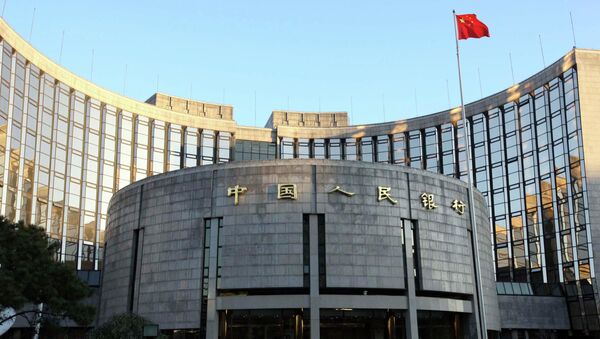MOSCOW, November 24 (Sputnik) — Asian and Australian stocks rallied Monday on Beijing’s interest rate cut, implemented last week, bringing optimism to the markets as stimulus is widely believed to accelerate China’s growth at this point.
Mainland China’s most prominent stock index climbed to a 3-year high today on the news of the People’s Bank of China (PBOC) rate cut, undertaken previously to provide more liquidity to the economy and ease regional governments’ debt burdens. Prospects of further monetary easing in China have heated optimism in the global markets’ outlook, as similar measures are anticipated in Europe, which will only contribute to new stock markets advances.
“The rally in Chinese shares will continue following the rate cut,” Nader Naeimi of the Sydney-based AMP Capital Investors Ltd. Said as quoted by Bloomberg. “Central banks can be aggressive in cutting rates because inflation isn’t an issue. We have been getting surprises from central banks. There’s a good chance we’ll see a move from the ECB soon.”
The MSCI Asia Pacific (sans Japan) Index rose 2.1% in Hong Kong in its largest advance in roughly a month. One of the MSCI key driving factors was the Hang Seng index's expansion by 3.6% on mainland property shares’ advance. Shanghai Composites added 1.83%, growing evidence that the HK-Shanghai Stock Connect scheme has only generated a weak market response after an initial boom on its mainland end. However, the mainland’s top index, the CSI300, gained 2.6% at its opening, which is its highest point since late May 2013.
“Stimulus has been the magic fix for equity markets over the past six years and the mere sign it will eventuate is enough to be championed by the markets,” Evan Lucas of IG Ltd. In Melbourne said as quoted by Bloomberg. “We now have three of the four largest central banks in the world actively stimulating their respective domestic economies.” The three major regulators that introduced stimulus measures to some extent are Bank of Japan (BoJ), European Central Bank (ECB) and POBC. The fourth one is the US Federal Reserve, who is planning to tightening monetary conditions in the distant future.
In Australia, the S&P/ASX200 Index rose 1.08%, driven by companies operating in China. Beijing’s easing has also contributed to the growth of Australian stocks which had seen multi-year lows due to cheaper commodities. Now, raw material prices are expected to rise on China’s anticipated acceleration. Australia’s leading iron producer Fortescue Metals Group skyrocketed 10.7% after dipping to a 5-year low Friday, according to Reuters data. New Zealand’s NZX50, however, dipped 0.44%, dragged down by New Zealand Oil and Gas Ltd, which lost 3% of its stock on the continued losing streak in global oil prices.
Singapore’s Straits Times Index rose to its highest since mid-September during the day, losing 0.06% afterwards on Singapore Telecommunications Ltd.’s losses.
A broader international stimulus action is set to replace the US Fed’s program. As the US distance themselves from being a locomotive for the global growth in favour of cooperating with its key partners within the Trans-Pacific Partnership (TPP) and Transatlantic Trade and Investment Partnership (TTIP), the rest of world is yet to find an alternative growth model.
"While U.S. quantitative easing may have ended, it's being replaced by QE in Japan and Europe and rate cuts in China," Shane Oliver of the Sydney-based AMP Capital said as quoted by Reuters. "This in turn augurs well for shares and other growth assets."
European shares are expected to continue Friday’s rally on the ECB easing perspective, however, today’s advances may be cautious on the news of the Iran nuclear deal, which may not happen. The Euro slid on the looming full-scale ECB easing action.
"We will do what we must to raise inflation and inflation expectations as fast as possible," ECB head Mario Draghi said Friday.
The US dollar slid 0.93% against the Russian ruble to 45.4 while the euro gained 0.05 against the dollar to $1.24. Russia’s national currency gains ahead of the November, 27 OPEC meeting which may see the world’s biggest oil exporters cut crude production. However, the outlook for the oil prices is still pessimistic for the exporters as the deal will be hard to reach amid the heated competition between Saudi Arabia and the US.
“OPEC can’t balance the market alone,” Qatari ex-Oil minister Abdullah Al Attiyah told Bloomberg. “This time, Russia, Norway and Mexico must all come to the table. OPEC can make a cut, but what will happen is that non-OPEC supply will continue to grow. Then what will the market do?”

